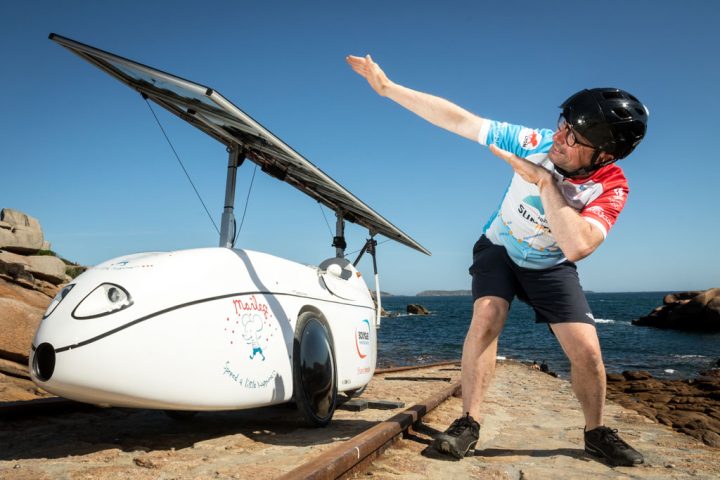
“The Sun Trip”: an incredible solar WAW race
Jean-Marc Dubouloz is one of the, meanwhile, 4 adventurers participating with a WAW in the Sun trip this year. His story is published first in his mother tongue, French, and after that in English. We hope it inspires you and wish the adventurers good luck!
PS : besides http://www.declic-eco.fr/ in France there is also https://biketothefuture.ch/ in Switzerland who adapts and prepares bicycles for a solar race.
« The Sun Trip » : une course incroyable en WAW solaire
Il n’était pas six heures, un beau matin de septembre 2018, naviguant sur Internet dans ma Normandie française, je tombe sur la vidéo relatant l’édition de juillet 2018 du Sun Trip « Lyon (France) – Canton (Chine) ».
Waouh… ce fut un véritable coup de foudre !
Immédiatement, je su que je voulais participer à ça.
Les images montraient d’étranges cyclistes progressant sur les pentes alpines, au fil des plaines d’Europe centrale, ou sous le ciel écrasant de la steppe kazakhe. Pédalant allongés à l’abri sous leurs panneaux solaires, ou les tractant sur une remorque attachée à leur vélo traditionnel, les concurrents du Sun Trip ralliaient Lyon à… Canton, 12 000 kilomètres plus loin !
Lancée en 2013, cette épreuve hors du commun se veut une sorte de « Vendée Globe terrestre ». Après avoir rallié Astana, puis l’Anatolie en 2015, l’aventure a pris toute sa dimension en 2018.
La règle en est simple : atteindre l’arrivée en autonomie sur des vélos (traditionnels ou couchés, etc.) à « assistance électro-solaire ». Toute recharge sur secteur étant strictement interdite, les concurrents avancent d’autant plus vite que le ciel est bleu. Inversement, jours de pluie et de grisaille réclament plus d’effort musculaire, promettant à la fois fatigue et moindres distances.
Il est par ailleurs interdit de rouler la nuit pour des raisons de sécurité, l’arrêt est obligatoire à 21H et la course ne peut reprendre avant 6 H le matin. Ce qui laisse quand même 15 H de vélo par jour…
On dort où on veut, au bord de la route, au camping, chez l’habitant, à l’hôtel. La tente fait donc partie du paquetage de base de chaque vélo.
Aucune trace GPX n’est fournie par l’organisation, les participants sont donc libres de choisir leur route (certaines zones géographiques étant interdites).
Ce qui m’a immédiatement séduit dans The Sun Trip, c’est ce mélange inédit d’aventure humaine, de sport, de technologie et c’est évidemment une nouvelle approche de la mobilité responsable qui ne peut que se développer dans les années à venir.
Il faut se rendre compte que l’énergie nécessaire à chaque participant pour rallier Canton est pour 1/3 d’origine musculaire et pour 2/3 photovoltaïque. C’est 180 kWh, soit environ l’équivalent de seulement 18 litres d’essence pour parcourir 12 000 km !
Une fois la décision prise de participer, il fallait donc que je m’équipe d’un vélo solaire. Cycliste amateur depuis 30 ans (environ 4000 km par an), je possède plusieurs vélos, VTT ou vélo de route, mais aucun ne ressemble de près ou de loin à ces drôles d’engins solaires.
Je me suis tout de suite dit que je voulais partir sur un vélo innovant et performant.
J’ai alors découvert le Vélomobile et j’ai perçu tout le potentiel de ce vélo grâce à son Cx inégalé.
Et comme cela n’avait jamais été testé sur cette course, le challenge m’attirait encore plus !
Pas à pas, j’ai construit ma réflexion en discutant et en rencontrant beaucoup de personnes impliquées sur le sujet.
Deux personnes ont été déterminantes dans ce choix.
Joël Vincent, le spécialiste en France du Vélomobile, https://cycles-jv-fenioux.com/. J’ai immédiatement sympathisé avec lui. Très professionnel, il m’a présenté et fait essayer différents modèles pour m’orienter rapidement vers le WAW, par rapport à mon besoin.
L’autre personne déterminante, c’est Guillaume Devot, le spécialiste en France du vélo solaire, http://www.declic-eco.fr/, qui a équipé la plupart des vélos participants au Sun Trip.
Il connait parfaitement les contraintes auxquelles sont soumis les vélos dans ce genre d’aventures. Il faut l’entendre raconter, par exemple, comment il a retrouvé les vélos qui arrivaient en Chine… il n’avait jamais vu des vélos dans un tel état.
Je comprends mieux pourquoi la première fois où je lui ai parlé au téléphone cela a donné ça :
– Bonjour, je voudrais participer au prochain Sun Trip.
– Oui
– Je voudrais participer en Vélomobile Solaire.
Grand silence, puis, un simple…
– C’est gonflé…
Nous nous sommes reparlés de nombreuses fois, je lui ai présenté mon projet et mon choix de partir en WAW.
Finalement, c’est lui qui, quelques semaines plus tard, me dit un jour :
- – Ton projet de faire ça en vélomobile, c’est vraiment gonflé… Mais cela me plait car ça n’a jamais été fait. Et puis, le WAW semble être le vélomobile le plus adapté pour The Sun Trip. Je veux bien t’accompagner sur ce projet.
Venant de lui, c’était un formidable encouragement et le début d’une amitié.
Pourquoi le WAW ?
C’est le meilleur compromis entre performances, solidité, et réparabilité.
Et en plus, il est beau !
C’est aussi le seul qui propose un tube vertical sur l’avant permettant de fixer le mat avant du panneau solaire. Car rapidement, je décidais de partir avec les panneaux fixés au-dessus du WAW.
J’ai écarté la solution de la remorque solaire, pour de nombreuses raisons, à commencer par le nombre de demi-tours que je fais par jour, lorsque je me trompe de chemin. Ce n’est déjà pas simple en vélomobile, mais avec une remorque de 3m en plus…
Les choix techniques étaient importants :
Comment fixer un panneau solaire de 2,5 m2 au-dessus de la tête, qui pèse près de 20kg ? Cela crée des efforts pour lesquels le WAW, comme tous les vélomobiles, n’a pas été conçu.
À cela, y ajouter une motorisation digne de ce nom : Grin RH212. Oui, Guillaume Devot ne jure que par les moteurs Direct Drive et ses arguments, lui qui a équipé tellement de vélos, ne manquent pas de poids. Notamment, la régénération qui est un élément important pour l’autonomie dans une journée.
Mon équipement électrique est composé de :
- – 1 Phaserunner, le meilleur contrôleur du marché.
- – 1 Cycle Analyst V3, afficheur qui permet de gérer la consommation électrique et la recharge solaire et de régénération, sur le même écran.
- – 2 batteries de 48V 11A, soit 1056 Wh (1100 Wh, c’est la limite du règlement du Sun Trip)
- – 4 panneaux solaires Sun Power de 120 Wp, soit 480 Wp. (2,5 m2, c’est la limite du règlement)
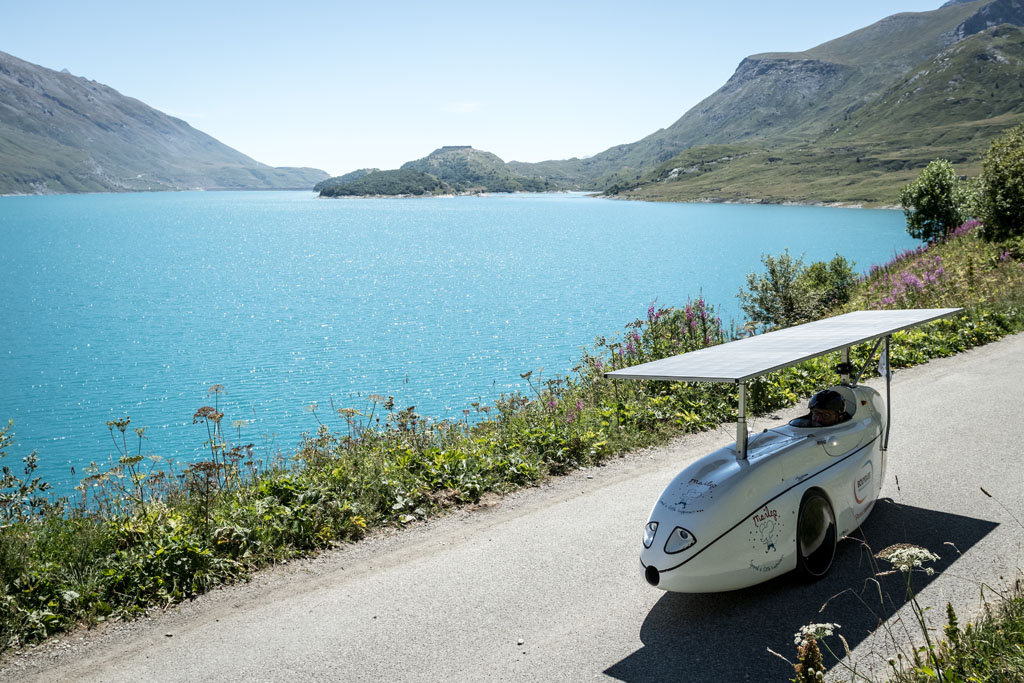
Une fois l’installation électrique et solaire réalisée, il faut penser à ce qu’il est nécessaire d’emporter pour cette longue course.
Ou plutôt, faire la liste de ce qu’il ne faut pas emporter, comme dans une grande randonnée en montagne.
La liste est longue et le choix d’autant plus difficile que l’espace est limité dans le WAW.
Le minimum de pièces de rechange, pneus, vis, et outils est nécessaire pour pouvoir réparer par soi-même au bord de la route. Même si le recours à de l’aide extérieur n’est pas interdite, la chance que le fabricant de vélo rencontré ait la bonne pièce de rechange est faible.
Je pars aussi bien avec un contrôleur de rechange qu’avec un kit de résine et composite, au cas où.
Il reste enfin le matériel de vie : tente, sac de couchage, pharmacie, et enfin seulement quelques vêtements pour les 2 mois de course.
Mais, comment vais-je faire si je suis invité à un dîner d’ambassadeurs ?
Heureusement que l’on n’emporte pas de nourriture, car on mange au bord de la route, quand on peut, dans cette course.
Quand on fait la liste, on se demande comment tout va rentrer ? et quel sera le poids pour tout ça ?
Et finalement, on arrive à tout rentrer !
Concernant le poids, on part d’un WAW Kevlar/carbone (plus adapté pour les longs voyages que le modèle full Carbone) qui pèse 34 kg à vide pour arriver à un WAW solaire prêt à partir qui pèse près de 160 kg… comprenant le pilote, prêt à rouler avec 2 litres d’eau et un peu de snacking.
Pour porter ce poids sur une si longue distance, il fallait donc faire quelques travaux sur le modèle de base.
Ce WAW n°383, acheté en avril 2019 chez Cycles JV-Fenioux a été équipé et transformé au printemps 2019.
- – Pose des panneaux solaires avec la mise en place de 2 mats avant et arrière qui supportent le cadre des panneaux solaires.
- – Remplacement de l’amortisseur arrière à air, par un amortisseur à ressors. Moins performant, mais incassable.
- – Renforcement des roues : changement jantes et rayons.
- – Pneus Marathon 1,5 à l’avant et Marathon Plus Tour 2,0 à l’arrière. Oui, je sais, ce n’est pas très performant, mais… je veux arriver au bout de la course.
- – Renforts Carbone à différents endroits, au niveau des tirants avant et sur le carénage de la roue arrière qui supporte le mat arrière.
- – Plein d’autres petites modifications.
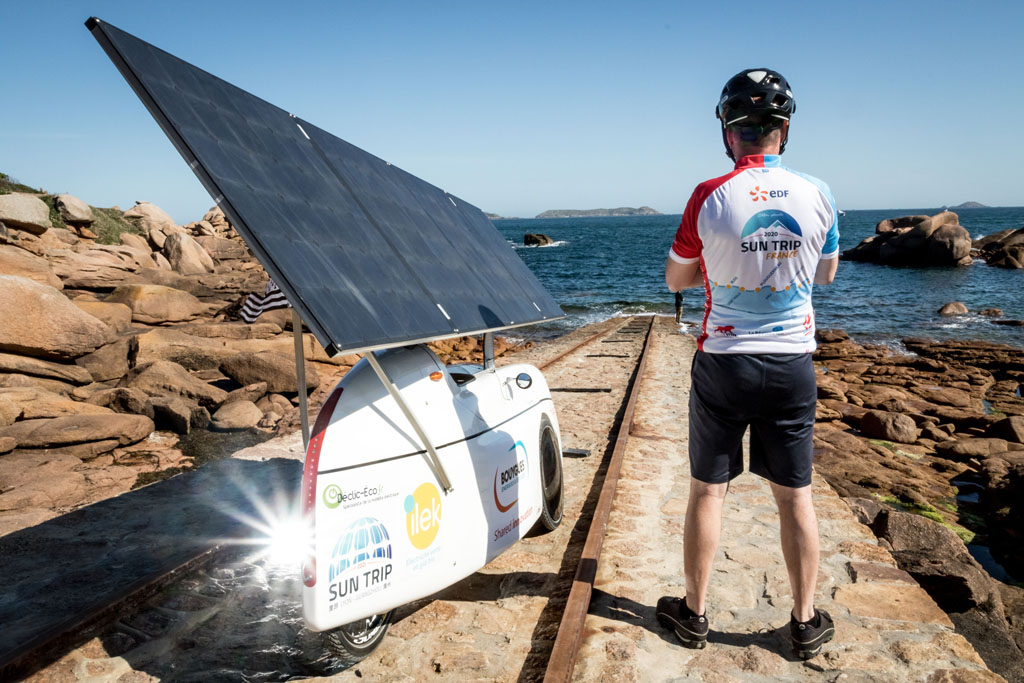
Enfin, côté course, le Sun Trip qui devait repartir en Chine en 2020 a été annulé à cause du Covid et remplacé au dernier moment par un Tour de France en vélo solaire, en juillet 2020.
Il ne s’agissait pas d’une course mais, d’un raid de 3500 km parcourus en 3 semaines avec beaucoup de grands cols du tour de France dans les Pyrénées et dans les Alpes. Au total 25 000 D+.
J’étais le seul velomobile parmi la vingtaine de concurrents.
Tout s’est très bien déroulé pour moi. Aucun problème rencontré, si ce n’est un moteur qui chauffe dans certains grands cols au-delà de 8%.
Ma plus longue journée a été de 340 km avec 4500 D+ dans les Alpes.
Une autre journée mémorable où j’ai rencontré du 40°C dans l’habitacle !
Au final, 3500 km en autonomie totale d’énergie grâce au soleil et à la régénération avec beaucoup d’expérience accumulée.
C’était un très bon test pour mon WAW solaire.
Depuis juillet 2019, j’ai ainsi parcouru 9000 km en continuant sans cesse d’améliorer mon vélomobile solaire.
Cette année, toujours à cause du Covid, le parcours vers la Chine est à nouveau reporté et remplacé par un grand tour d’Europe pour lequel je me sens prêt.
C’est presque aussi long que pour aller en Chine avec 11 000 km. C’est un gros challenge, car il faut pouvoir rouler tous les jours plus de 10 heures par jour sans s’arrêter…pendant près de 2 mois, avec un objectif journalier entre 250 et 300 km/jour.
Et si le soleil n’est pas là… ce sera encore plus dur.
Le départ est prévu autour du 15 juin de Bruxelles et trois autres vélomobiles sont inscrits dont deux autres WAW qui auront sans doute une approche solaire différente de la mienne.
Cela va faire une belle bande de velomobiles !
Vous pourrez suivre tous les concurrents sur la cartographie du site The Sun Trip, comme pour les bateaux du Vendée Globe. Les positions seront rafraichies tous les 15min sur la carte.
A l’image de Stephane Boving de Katanga qui me propose gentiment un support avant et pendant la course, si la communauté des amis du WAW veut me soutenir par ses encouragements, à travers ma page facebook.com/jm.dubouloz et instagram.com/canton_veut_on_peut , ce sera avec plaisir !
Si l’un de vous est sur mon chemin pour m’accueillir pour une nuit ce sera encore avec plaisir.
Jean-Marc Dubouloz
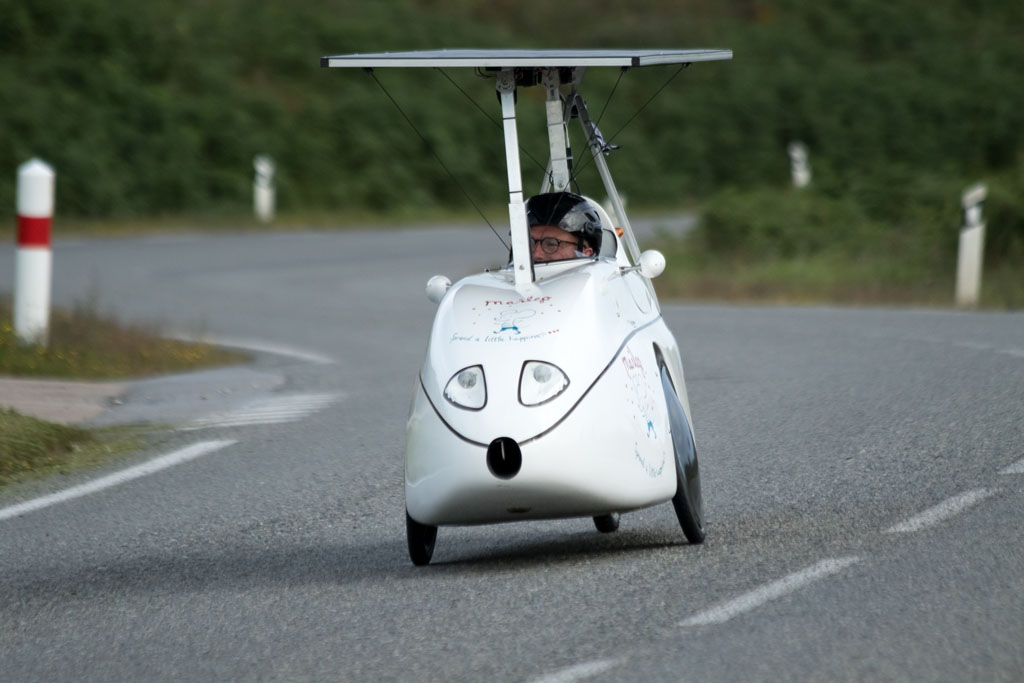
“The Sun Trip”: an incredible solar WAW race
It was not yet six o’clock, a beautiful morning in September 2018, surfing the Internet in my French Normandy, when I came across the video relating the July 2018 edition of the Sun Trip “Lyon (France) – Canton (China)”.
Waw… I mean Wow… it was love at first sight!
Immediately I knew I wanted to participate in this. The images showed strange cyclists progressing on alpine slopes, over the plains of central Europe, or under the overwhelming skies of the Kazakh steppe. Pedaling lying in the shelter under their solar panels, or towing them on a trailer attached to their traditional bicycle, the competitors of the Sun Trip rallied Lyon to … Canton, 12,000 kilometers away!
Launched in 2013, this extraordinary event is a sort of “terrestrial Vendée Globe”. After joining Astana, then Anatolia in 2015, the adventure took on its full dimension in 2018. The rule is simple: reach the finish in autonomy on bicycles (traditional or recumbent, etc.) with “electro-solar assistance”.
As any recharging on the grid is strictly prohibited, the competitors move faster as the sky is blue. Conversely, rainy and gray days require more muscular effort, promising both fatigue and shorter distances.
It is also forbidden to drive at night for safety reasons, stopping is compulsory at 9 p.m. and the race cannot resume before 6 a.m. in the morning. Which still leaves 15 hours of cycling per day …
We sleep wherever we want, by the side of the road, at the campsite, with locals, at hotels. The tent is therefore part of the basic package of each bike.
No GPX track is provided by the organization, so participants are free to choose their route (certain geographical areas are prohibited).
What immediately appealed to me in The Sun Trip is this unprecedented mix of human adventure, sport, technology and it is obviously a new approach to responsible mobility which can only develop in the years to come.
You have to realize that the energy required for each participant to reach Canton is 1/3 of muscular origin and 2/3 of photovoltaic energy. That’s 180 kWh, or about the equivalent of just 18 liters of gasoline to cover 12,000 km!
Once the decision was made to participate, I therefore had to equip myself with a solar bike.
As amateur cyclist for 30 years (around 4000 km per year), I own several bikes, mountain bikes or road bikes, but none closely or remotely resembles these funny solar machines.
I immediately told myself that I wanted to go on an innovative and efficient bike. I then discovered the Velomobile and saw the full potential of this bike, thanks to its unmatched Cx.
And as it had never been tested in this race, the challenge attracted me even more!
Step by step, I built my thinking by discussing and meeting a lot of people involved on the subject. Two people were decisive in this choice.
Joël Vincent, the Velomobile specialist in France, https://cycles-jv-fenioux.com/. I immediately sympathized with him. Very professional, he introduced me and made me try different velomobile models to quickly orient me towards the WAW, according to my need.
The other decisive person is Guillaume Devot, the solar bike specialist in France, http://www.declic-eco.fr/, who equipped most of the bikes participating in the Sun Trip.
He is fully aware of the constraints to which bikes are subjected in this kind of adventure. You have to hear him tell, for example, how he found the bikes arriving in China after 12 000 km … he had never seen bikes in such condition.
I understand better why the first time I spoke to him on the phone it went like this:
– Hello, I would like to participate in the next Sun Trip.
– Yes
– I would like to participate in a Solar Vélomobile.
Great silence, then, a simple …
– It’s pretentious …
We spoke to each other many times. I presented my project and my choice to go to WAW. Finally, it was he who, a few weeks later, said to me, one day:
– Your plan to do that in a velomobile, it’s really pretentious … But I like it because it has never been done. And then, the WAW seems to be the most suitable velomobile for The Sun Trip. I want to accompany you on this project.
Coming from him, it was a tremendous encouragement and the start of a friendship.
Why the WAW?
This is the best compromise between performance, strength, and repairability.
And in addition, it is beautiful!
It is also the only one that offers a vertical tube on the front to secure the front mast of the solar panel. Because quickly, I decided to leave with the panels fixed above the WAW.
I ruled out the solar trailer solution, for many reasons, starting with the number of U-turns I do per day, when I take the wrong path. It’s not easy on a velomobile, but with a 3m trailer …
The technical choices were important: How to fix a solar panel of 2.5 m2 above the head, which weighs almost 20 kg? This creates stresses that the WAW, like all velomobiles, was not designed for. To that, add a motorization worthy of the name: Grin RH212. Yes, Guillaume Devot swears by Direct Drive engines and his arguments, he who has equipped so many bikes, are not lacking in weight. In particular, regeneration, which is an important element for autonomy in a day.
My electrical equipment is made up of:
- – 1 Phaserunner, the best controller on the market.
- – 1 Cycle Analyst V3, display that allows you to manage electricity consumption and solar and regeneration recharging, on the same screen.
- – 2 batteries of 48V 11A, i.e. 1056 Wh (1100 Wh, this is the limit of the Sun Trip regulations)
- – 4 Sun Power solar panels of 120 Wp, or 480 Wp. (2.5 m2, this is the limit of the regulations)
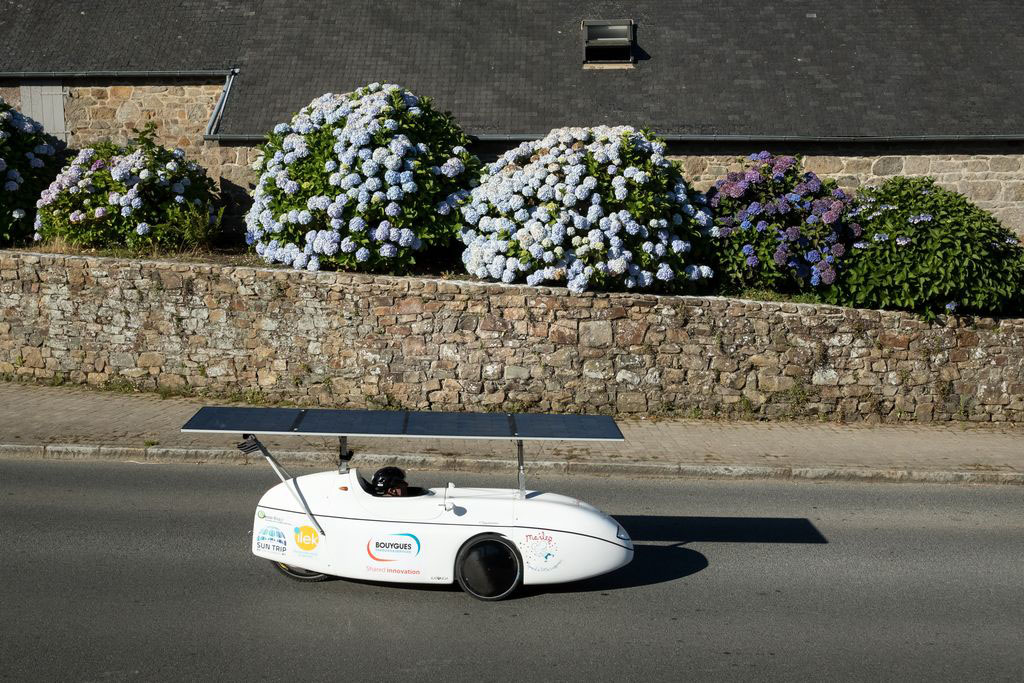
Once the electrical and solar installation is complete, you have to think about what to pack for this long race. Or rather, make a list of what not to pack, like on a long mountain hike…
The list is long and the choice is all the more difficult as space is limited in the WAW.
The minimum of spare parts, tires, screws, and tools are necessary to be able to repair by oneself at the side of the road. Even if the use of outside help is not prohibited, the chance that the bicycle manufacturer encountered has the correct spare part is low.
For example, I go with both a spare controller and a resin and composite kit, just in case.
Finally, there are the living equipment: tent, sleeping bag, pharmacy, and finally only a few clothes for the 2 months of the race. – what am I going to do if I am invited to an Ambassadorial Dinner?-
Fortunately, we are not taking food, because we eat by the side of the road, when we can, in this race.
When we make the list, we wonder how everything will fit? and what will be the weight for all that? And finally, we manage to fit everything!
Regarding the weight, we start with a Kevlar / carbon WAW (more suitable for long trips than the full carbon model) which weighs 34 kg empty to arrive at a ready-to-go solar WAW which weighs nearly 160 kg … including the pilot, ready to roll with 2 liters of water and a little snacking.
To carry this weight over such a long distance, it was therefore necessary to do some work on the base model.
This WAW n ° 383, bought in April 2019 from CyclesJV-Fenioux was equipped and transformed in spring 2019.
– Installation of solar panels with the installation of 2 front and rear masts which support the frame of the solar panels.
– Replacement of the rear air shock absorber with a spring shock absorber. Less efficient, but unbreakable.
– Reinforcement of the wheels: change rims and spokes.
– Marathon 1.5 tires at the front and Marathon Plus Tour 2.0 tires at the rear. Yeah, I know it’s not very good, but … I want to get to the end of the race.
– Carbon reinforcements in different places, on the front tie rods and on the rear wheel fairing which supports the rear mast.
– Lots of other small changes.
Finally, on the racing side, the Sun Trip which was to return to China in 2020 was canceled because of the Covid and replaced at the last moment by a Tour de France by solar bike, in July 2020. It was not a race, but a 3,500 km raid covered in 3 weeks with many great Tour de France passes in the Pyrenees and the Alps. In total 25,000 meter denivelation.
I was the only velomobile among the twenty or so competitors. Everything went very well for me. No problem encountered, except for an engine that heats up in some large passes above 8%.
My longest day was 340 km with 4500 D + in the Alps. Another memorable day where I encountered 40 ° C in the cabin!
In the end, 3500 km in total energy autonomy thanks to the sun and regeneration with a lot of accumulated experience. It was a very good test for my Solar WAW.
Since July 2019, I have traveled 9,000 km, constantly continuing to improve my solar velomobile.
This year, again because of the Covid, the route to China is again postponed and replaced by a grand tour of Europe for which I feel ready.
It’s almost as long as going to China at 11,000 km. It’s a big challenge, because you have to be able to ride every day for more than 10 hours a day without stopping … for almost 2 months, with a daily goal of between 250 and 300 km / day. And if the sun isn’t there … it will be even harder.
The start is scheduled for around June 15 from Brussels and three other velomobiles are registered including two other WAW which will undoubtedly have a different solar approach to mine. This will make a nice bunch of velomobiles!
You will be able to follow all the competitors on the map of The Sun Trip site, as for the Vendée Globe boats. The positions will be refreshed every 15min on the map.
Like Stephane Boving from Katanga who kindly offers me support before and during the race, if the community of WAW friends wants to support me with their encouragement, through my Facebook.com/jm.dubouloz and instagram.com page / canton_veut_on_peut, it will be with pleasure!
If one of you is on my way to welcome me for a night, it will be a pleasure again.
Jean-Marc Dubouloz
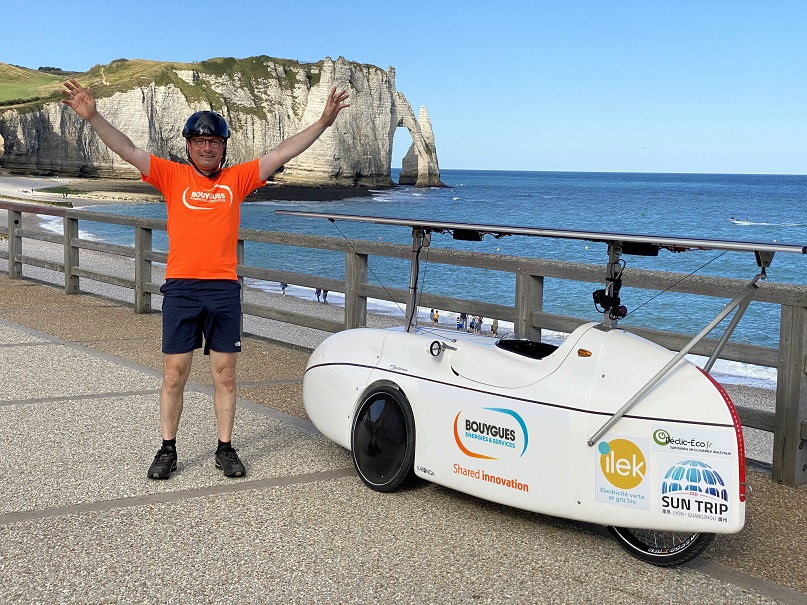

Leave a Reply